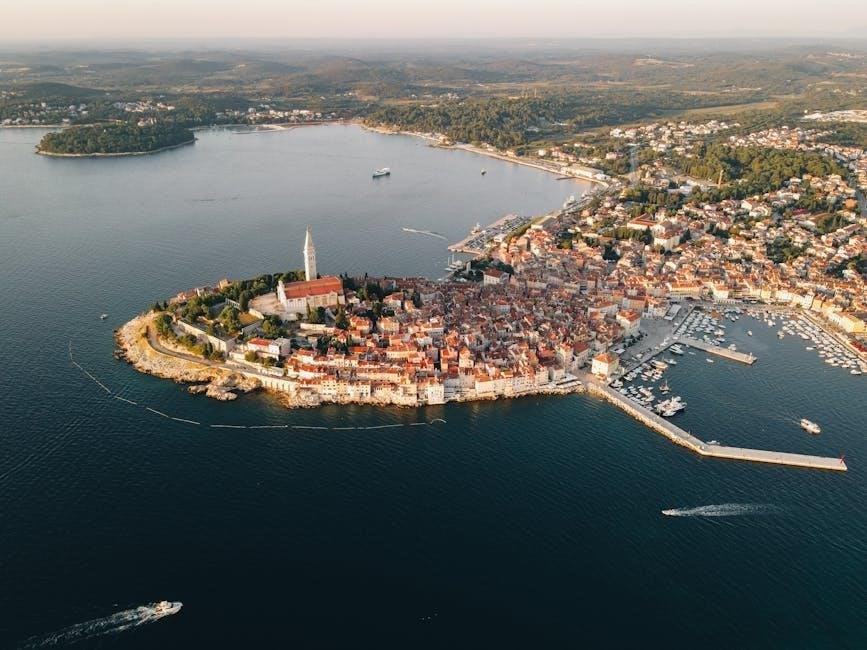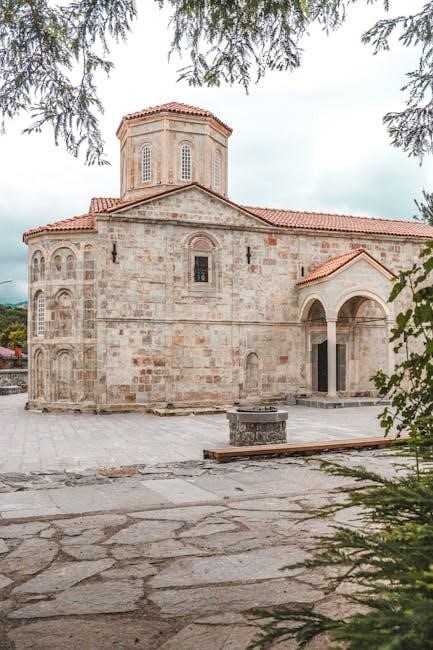Guido Reni’s St․ Michael (1635) is a captivating Baroque masterpiece depicting the archangel defeating Satan․ Commissioned for the Church of the Capuchins in Rome, it showcases Reni’s refined style, blending dramatic tension with serene elegance, embodying the triumph of good over evil․
Overview of the Painting
St․ Michael Defeating Satan, painted by Guido Reni in 1635, is a large-scale oil on canvas measuring 293 x 202 cm․ Created for the Church of the Capuchins in Rome, it captures the dramatic moment of the archangel triumphing over the devil․ The painting is striking for its balance of intense action and serene composure, with St․ Michael depicted in a Roman military cloak and cuirass․ The work is characterized by Reni’s mastery of light and shadow, emphasizing the divine and the heroic․ Its composition and emotional depth reflect the Baroque style, making it a celebrated example of 17th-century religious art․ The painting is now in the public domain, widely admired for its historical and artistic significance․
Historical Context of the Work
St․ Michael Defeating Satan was painted in 1635 during the height of the Baroque period, a time of religious and artistic renewal in Rome․ Commissioned by Cardinal Sant’Onofrio, brother of Pope Urban VIII, the painting was created for the Church of the Capuchins, reflecting the era’s emphasis on religious art to inspire devotion․ The work aligns with the Counter-Reformation’s goals of reaffirming Catholic doctrine through powerful visual narratives․ Reni’s depiction of St․ Michael as a symbol of divine justice resonated deeply in a society seeking moral and spiritual guidance․ The painting also underscores the cultural and religious significance of St․ Michael as a protector and warrior of faith, making it a seminal work of its time․
Commission and Purpose
St․ Michael Defeating Satan was commissioned in 1635 by Cardinal Sant’Onofrio, brother of Pope Urban VIII, for the Church of the Capuchins in Rome․ The painting served as a powerful visual narrative to inspire devotion and reinforce Catholic doctrine during the Counter-Reformation․ Its purpose was to depict St․ Michael as a symbol of divine justice and triumph over evil, aligning with the Church’s efforts to strengthen faith․ Reni’s work was intended to be a spiritual focal point, evoking awe and contemplation among worshippers․ The painting’s grand scale and dramatic composition reflect its sacred mission, making it a central piece in the church’s art collection․

The Artwork: St․ Michael Defeating Satan

St․ Michael Defeating Satan is a dramatic oil painting by Guido Reni, created in 1635․ It vividly captures the archangel’s triumph over evil with intense emotion․
Iconography and Composition
Guido Reni’s St․ Michael Defeating Satan masterfully combines religious iconography with dynamic composition․ The archangel, dressed in a Roman military cloak and cuirass, embodies divine authority․ His serene yet resolute expression contrasts with the chaotic depiction of Satan as a dragon with a human-like face․ Reni’s use of dramatic lighting and shadows emphasizes the struggle between good and evil․ The composition is balanced yet tense, with Michael’s poised stance and outstretched sword dominating the scene․ The dragon, twisted and defeated, symbolizes evil’s downfall․ The painting’s design draws the viewer’s eye upward, reinforcing the theme of celestial triumph and moral victory․ Reni’s meticulous attention to detail and symbolic elements creates a visually compelling narrative․
Symbolism in the Painting
Guido Reni’s St․ Michael Defeating Satan is rich in symbolism, reflecting themes of divine justice and the triumph of good over evil․ The archangel Michael, depicted in a Roman military cloak and cuirass, symbolizes divine authority and strength․ His serene expression signifies divine calm and resolve․ Satan, represented as a dragon with a human face, embodies evil’s dual nature: bestial yet cunning․ The painting’s dramatic lighting contrasts divine light with darkness, symbolizing purity versus sin․ Michael’s outstretched sword represents truth and justice, while his dominance over the dragon underscores the inevitability of evil’s defeat․ The composition reinforces the eternal struggle between good and evil, with Michael’s poised stance embodying divine intervention and moral victory․ The imagery aligns with Catholic iconography, emphasizing divine justice and the Church’s teachings․
Artistic Style and Technique
Guido Reni’s St․ Michael Defeating Satan exemplifies his refined Baroque style, blending classical elegance with dramatic intensity․ The painting features strong chiaroscuro, with vivid contrasts of light and dark that highlight the dynamic forms of the archangel and the defeated Satan․ Reni’s precise brushwork and smooth technique create a sense of realism and detail, particularly in the flowing drapery of Michael’s robes and the intricate depiction of Satan as a dragon․ The composition is balanced yet energetic, capturing the tension of the moment․ The use of muted colors focuses attention on the central figures, enhancing the emotional depth of the scene․ This work showcases Reni’s mastery of both artistic technique and narrative expression, embodying the triumph of good over evil with grace and power․
Biblical and Cultural Significance
Guido Reni’s St․ Michael embodies the biblical triumph of good over evil, resonating deeply in Christian art and faith․ Its dramatic imagery has inspired cultural reverence and devotion, symbolizing divine justice and the eternal struggle between light and darkness․

St․ Michael in Religious Art
St․ Michael, as a prominent figure in religious art, is often depicted as a powerful archangel defeating Satan, symbolizing divine justice and protection․ In Guido Reni’s rendition, Michael’s serene yet resolute expression contrasts with the chaos of the fallen dragon, emphasizing his role as a celestial warrior․ This imagery aligns with biblical narratives, particularly from the Book of Revelation, where Michael leads the heavenly host against the forces of evil․ Reni’s portrayal not only reflects traditional iconography but also infuses it with Baroque emotional depth, making it a quintessential representation of St․ Michael in sacred art, revered for its spiritual and aesthetic impact․
Cultural Impact and Legacy
Guido Reni’s St․ Michael Defeating Satan has left a profound cultural impact, becoming an iconic representation of the eternal struggle between good and evil․ Its Baroque style, characterized by dramatic lighting and emotional intensity, influenced countless artists and religious artworks․ The painting’s public domain status has allowed it to be widely reproduced and referenced in various media, from films to literature․ Its depiction of St․ Michael as a serene yet powerful figure has cemented the archangel’s image in popular culture․ Additionally, the artwork’s historical significance is enhanced by its association with the Church of the Capuchins in Rome, where it was originally displayed, making it a cornerstone of religious and artistic heritage․

Guido Reni: The Artist
Guido Reni, a prominent Italian Baroque painter, created iconic works like St․ Michael․ His art, known for harmony and emotional depth, influenced many artists and remains widely celebrated․
Biography and Career
Guido Reni, born in 1575 in Bologna, Italy, was a renowned Baroque painter whose work bridged classicism and emotional intensity․ Trained under Denys Calvaert and later the Carracci brothers, Reni developed a distinctive style characterized by graceful forms, harmonious compositions, and expressive use of light․ His career flourished in Bologna and Rome, where he executed altarpieces, frescoes, and mythological scenes․ Reni’s fame spread across Italy and Europe, earning him prestigious commissions․ Despite personal struggles, including gambling debts, he remained a leading artist of his time, influencing later painters and leaving a legacy of poetic and emotionally resonant works․
Other Notable Works
Guido Reni’s artistic repertoire extends beyond St․ Michael to include numerous iconic works․ His Massacre of the Innocents (1611) is celebrated for its emotional depth and dynamic composition․ Europa and the Bull (1640) showcases his mastery of mythological themes, while David and Goliath (1610) highlights his ability to capture dramatic tension․ Reni’s frescoes in the Vatican’s Casino Ludovisi and his altarpieces, such as Christ at the Column (1625), further exemplify his technical brilliance and emotional expression․ These works solidified his reputation as one of the Baroque era’s most versatile and influential artists, blending elegance with profound narrative power․

Themes and Interpretations
Guido Reni’s St․ Michael embodies the universal theme of good vs․ evil, with the archangel’s serene strength contrasting Satan’s chaotic form, symbolizing divine triumph and moral clarity․
Good vs․ Evil
Guido Reni’s St․ Michael vividly captures the timeless struggle between good and evil․ The archangel, depicted with calm determination, triumphs over Satan, represented as a chaotic, monstrous figure․ Reni’s composition emphasizes the contrast between light and darkness, with Michael’s radiant form symbolizing virtue, while Satan’s twisted posture embodies malevolence․ The painting reflects the universal theme of divine order prevailing over chaos, reinforcing the archangel’s role as a protector and defender of faith․ Reni’s masterful use of chiaroscuro heightens the dramatic tension, creating a powerful visual narrative of moral conflict and redemption․
Emotional and Spiritual Depth

Guido Reni’s St․ Michael embodies profound emotional and spiritual depth, capturing the archangel’s serene determination as he triumphs over Satan․ The painting conveys a sense of divine calm, with Michael’s composed expression reflecting his unwavering faith and purpose․ In contrast, Satan’s twisted form evokes turmoil and despair, symbolizing the struggle between light and darkness․ Reni’s use of chiaroscuro enhances the emotional impact, casting a spiritual glow on Michael while shrouding Satan in shadow․ This stark contrast underscores the universal themes of redemption and divine order, inviting viewers to reflect on the triumph of virtue over adversity․ The artwork’s emotional resonance lies in its ability to inspire hope and contemplation․
Historical and Provenance
Guido Reni’s St․ Michael (1635) was commissioned for the Church of the Capuchins in Rome․ It is currently housed in a church and is in the public domain․
Location and Preservation
Guido Reni’s St․ Michael Defeating Satan is housed in the Church of the Capuchins in Rome, where it was originally commissioned․ The painting is well-preserved and remains in its original location, a testament to its historical significance․ As a public domain work, it is widely accessible for viewing and study․ The oil on canvas piece measures 293 x 202 cm, showcasing its grandeur․ Its condition reflects meticulous care over the centuries, ensuring its vivid details and emotional depth remain intact for future generations to admire․
Public Domain Status
Guido Reni’s St․ Michael Defeating Satan is in the public domain, as the copyright has expired․ This status applies in countries where the copyright term is the artist’s lifetime plus 100 years․ Since Reni passed away in 1642, the painting is freely accessible for reproduction, study, and adaptation without copyright restrictions․ Its public domain status ensures that it is widely available for educational and artistic purposes, allowing audiences to appreciate and share this Baroque masterpiece globally․ The painting’s digital versions are also freely downloadable from various online platforms, making it a valuable resource for art lovers and scholars alike․